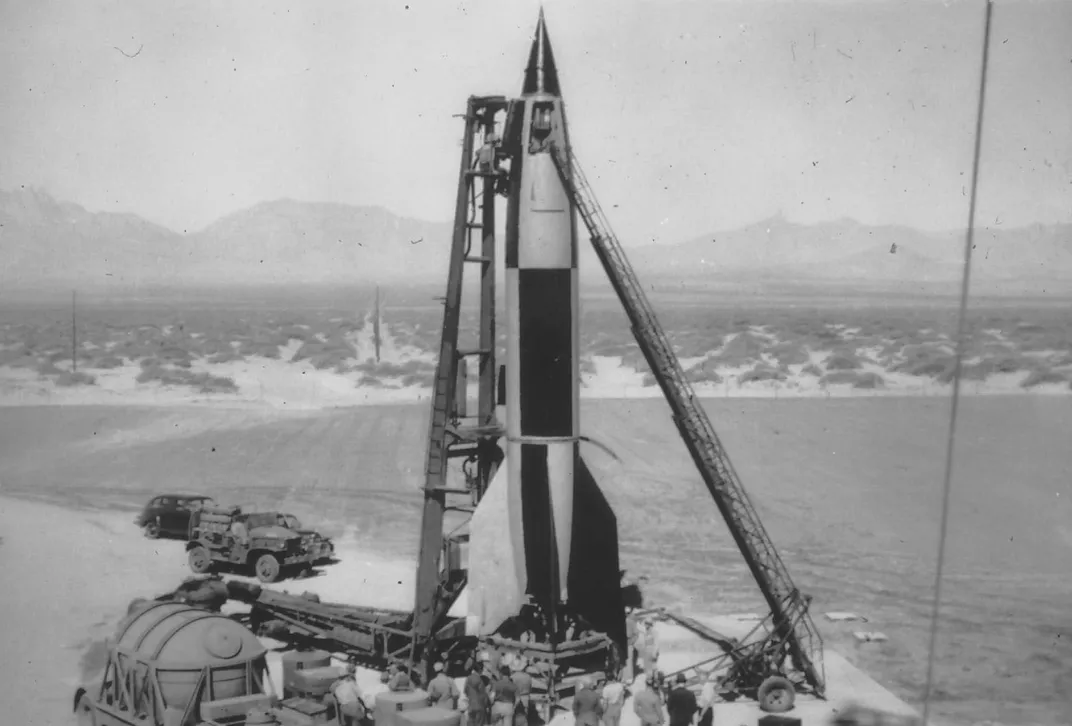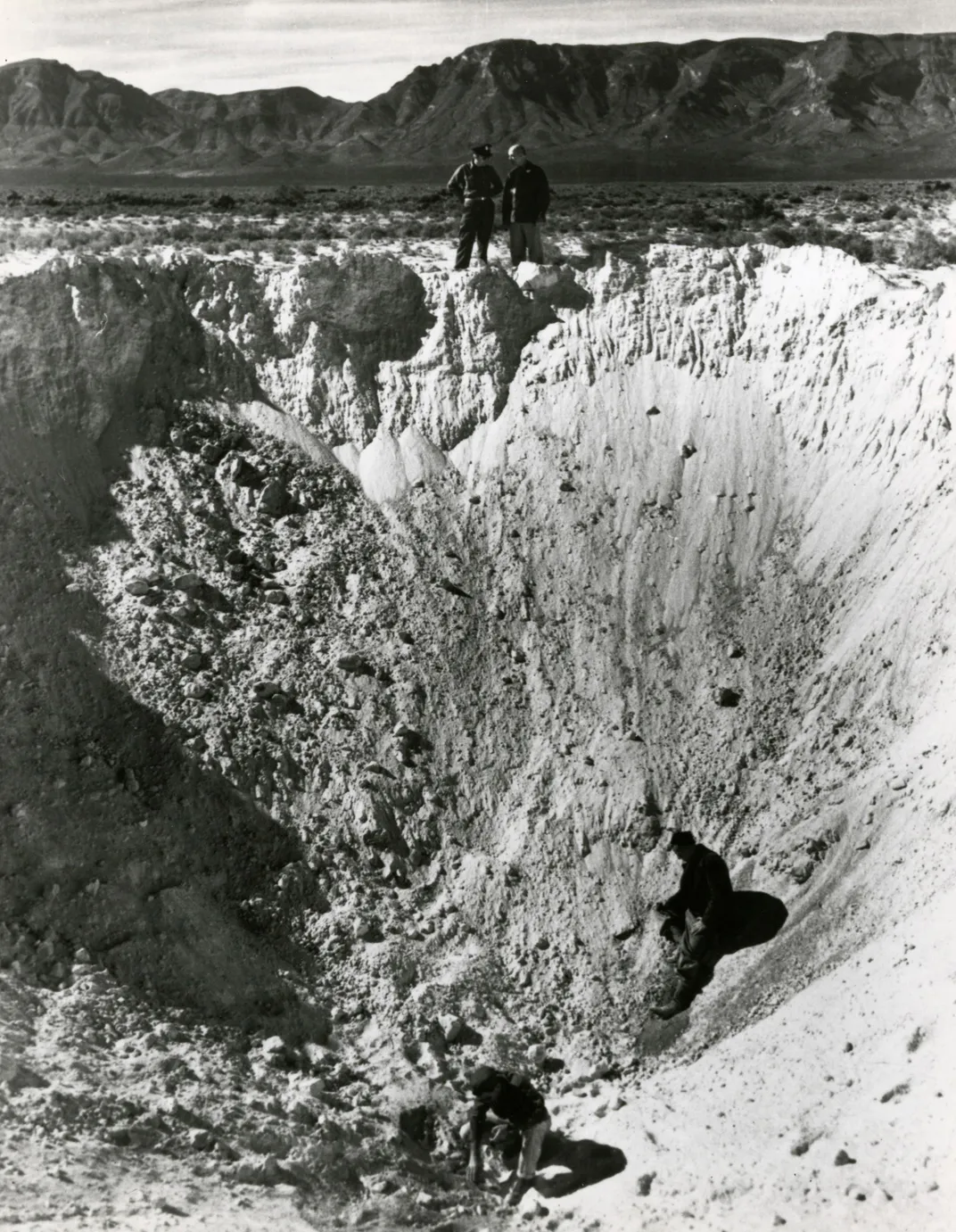The First Launch of a V-2 Rocket From America
Captured German missiles took flight from the New Mexico desert in the early years after World War II.
:focal(605x560:606x561)/https://tf-cmsv2-smithsonianmag-media.s3.amazonaws.com/filer/78/27/782718be-568e-4383-b84d-76677349736e/si-79-13149_p.jpg)
At 2:47 on the afternoon of Tuesday, April 16, 1946, a captured Nazi V-2 missile ascended from the U.S. Army’s new White Sands Proving Ground in south-central New Mexico. It didn’t get very far. The guidance system failed, a fin came off, and the rocket—after reaching an altitude of only 3.4 miles—crashed in the desert.
Almost exactly one year earlier, American troops had overrun the underground Mittelwerk V-weapons production plant in central Germany, in the process liberating several hundred very sick concentration camp prisoners in the adjacent camp and in the nearby city of Nordhausen. After the war was over, and before the Soviets could move into their designated occupation zone, U.S. Army Ordnance teams evacuated components for a hundred V-2s and shipped them off to the Southwest desert to gain experience operating the world’s first ballistic missile.
Assisting in the first American launch were some of the very German rocket engineers who had designed the rocket used to kill people in Paris, London and Antwerp. A group of about 125, led by Wernher von Braun, had been imported under Project Paperclip, which aimed to transfer German technological knowledge to the U.S. military and industry.
The von Braun group was housed at Fort Bliss outside El Paso, just across the Texas line. But they weren’t put in charge of the V-2 launches. The General Electric Company was responsible for preparing rockets at White Sands under the Army’s Hermes program, which, following the discovery of the German rocket program in 1943, was initiated to develop guided missiles. Over time, as American personnel gained more experience, the German role in assisting GE at White Sands diminished. The von Braun team’s primary job would be to develop Hermes II, an experimental ramjet cruise missile launched on top of a V-2.

Three-and-a-half weeks after the first launch attempt on April 16, GE personnel tried again, assisted by the Army, the Germans, and two research groups tied to the Navy. On May 10, the second V-2 ascended to an altitude of 70 miles (113 kilometers), well over the 100 km line now widely accepted as the definition of where space begins. It was the first launch into space from the United States, and by anyone except the Germans, whose V-2 had routinely crossed that line during wartime testing and operations of the ballistic missile in Europe.
Inside the nosecone of the April 16 and May 10 rockets, as well as other early White Sands V-2s, were heavy steel cylinders containing experimental equipment. Col. Holger Toftoy, the Army Ordnance officer in charge of the rocket program, had seen from the outset that V-2 flights provided an opportunity to do science in the upper atmosphere and near space. Such research would not only provide new knowledge, it would help the military understand the environment through which missiles would pass.

The primary experiment on the first flights was Dr. James Van Allen’s cosmic ray detector. Van Allen worked for the John Hopkins University’s Applied Physics Laboratory in Silver Spring, Maryland, which had developed the proximity fuse for artillery shells in World War II. Based on his experience designing a miniature radar set that could withstand drastic acceleration, Van Allen believed he knew how to create equipment that could survive the forces of launch and impact.
Ernst Krause’s Naval Research Laboratory team from Washington, DC, also placed inside these first V-2s armored cylinders containing test film for future experiments. At the time, radio telemetry was primitive and unreliable, and scientists wanted to recover the recording devices. Unfortunately, there was no money or time to develop a separable nosecone that would descend on a parachute. So Van Allen, Krause and others hoped that the heavy steel containers would survive impact in a salvageable form. But after the first successful launch on May 10, when they finally found the crater 61 miles away in the desert there was only a huge crater surrounded by metallic shards. Even following the April 16 failure, which impacted at a lower velocity, nothing usable was recovered. Four more successful V-2 launches into space from late May to early July produced similar results.
The solution to the problem came unexpectedly. The scientists’ first idea was to separate the warhead section, which the Army might want anyway for missile development. But on the first flight on which the separation system worked properly (also the first flight to ascend over 100 miles), it was the missile’s main body, not the nosecone, that survived in recognizable form after impact. No longer streamlined, the July 30 rocket tumbled all the way down, shedding velocity. Here was the place to put an armored instrument—in a tail fin. Finally, on the October 10 flight, the Naval Research Laboratory team recovered its ultraviolet spectrograph in a usable form. The retuned film revealed the first evidence of what the Sun’s spectrum looked like beyond the blocking effects of the Earth’s atmosphere. And two weeks after that, a 35-millimeter camera on a V-2 captured the first grainy, black-and-white images of Earth from space.
Contrary to Toftoy’s expectations that the White Sands V-2 campaign would be brief, launches went on until 1952, for both military and scientific purposes. More than 70 refurbished and modified German rockets were fired from White Sands—as well as one from a Navy ship at sea. Even before the V-2s ran out, the Army and Navy developed other rockets to replace it, like the Aerobee and Viking, both on view next to the V-2 in the National Air and Space Museum’s Space Race gallery. As museum curator David DeVorkin has written in his classic account of the early years at White Sands, Science with a Vengeance (1992), it was the military, not civilian government agencies, who created the U.S. space sciences after World War II.